Moving the blog, such-as-it-is to my own site: <http://www.jmjamison.com/posts/>.
More of the same: plants, cats, messy projects, etc.
what i do while the paint is drying: ongoing weaving/knitting/dye projects, experiments with local dye plants, garden trash and other messy endeavors.
Moving the blog, such-as-it-is to my own site: <http://www.jmjamison.com/posts/>.
More of the same: plants, cats, messy projects, etc.
That time of the year again. When the Oxalis makes another pass at taking over the yard. Fortunately the bees really like it and it makes a good dye for cotton and wool.
(Old post notes about dyeing with Oxalis)
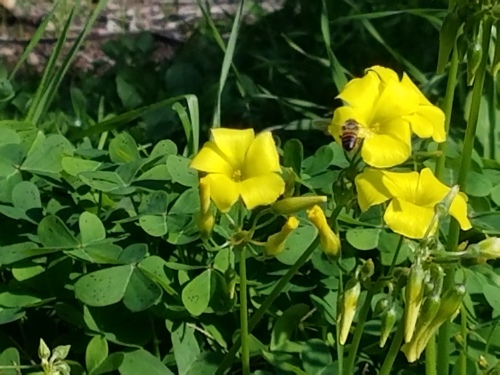
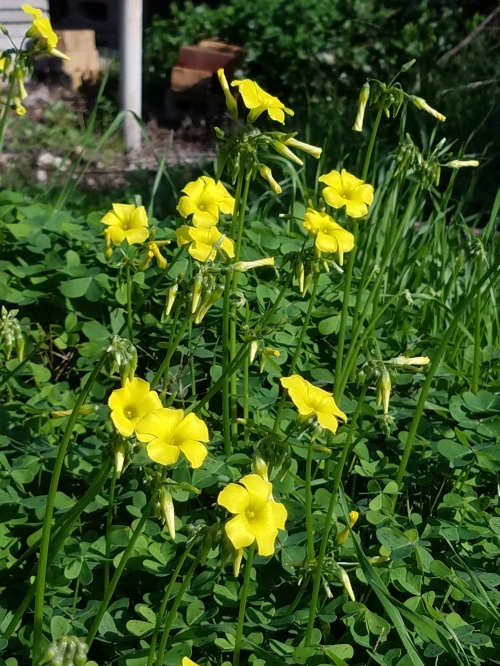
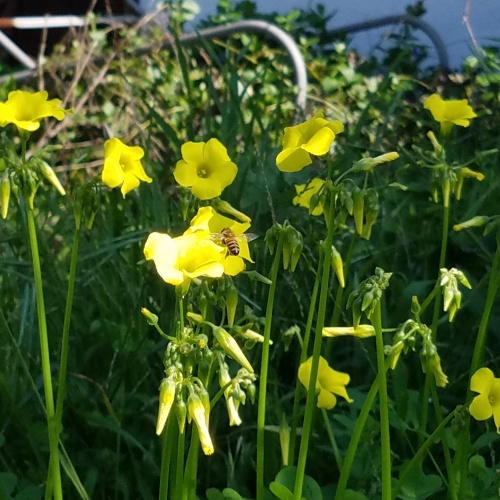
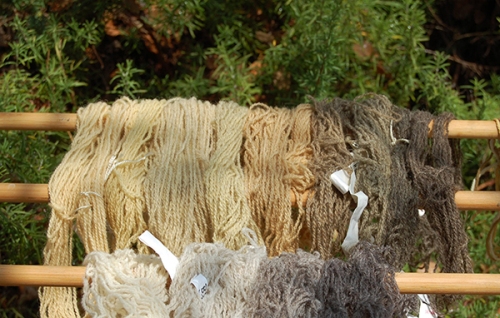
I have lots of Rosemary. Even sharing it, making incense and medicinals there’s lots left over. At some point it does have to be trimmed back so I tried it out as a dye plant.

The bottom row is what I started out with, my standard Bartlett yarn ‘natural white’, light gray, medium and dark gray. Cotton was unsuccessful.
For the dye stuff, starting with Ida Grae’s suggestions* I used fresh Rosemary 1×1 and 3×1. Simmered the Rosemary for an hour and let it cool over night.
Here are a couple of sites that describe Rosemary as a dye.
Naturally Dyeing: <http://naturallydyeing.blogspot.com/2011/05/rosmarinus-officinalis.html>
Dyeing Fabric with Culinary Herbs: <http://www.motherearthliving.com/garden-projects/culinary-herb-goes-dye-crazy.aspx>
Ida Grae points out that most cooking herbs will produce yellows. If I can eat or use something as a medicinal I tend not to dye with it but the Rosemary here is so plentiful it’s worth trying. Same probably goes for Lavender but I haven’t tried that yet.
*Ida Grae / Nature’s Colors: Dyes from Plants, 1979.
This was back in April the Weld started shooting up.
The tomato cage might give an indication of the height of the plant. I’ve seen them grow much taller. This one however is flowering so it’s unlikely to see more growth.
Almost ready for seed saving.
This Weld plant popped up nearby so I put the bricks around it – my universal marker for this-is-not-really-a-weed-dont-pull-or-stomp-on. With any luck this one will have the tenacity to survive the current drought conditions.

Woad in yard, March 2016
This is the surviving Woad plant from last year.
I recently found a cone of white pearl cotton at a local thrift shop. The obvious thing of course was dye experiment. The usual oxalis and onion, woad overdye attempts were lighter than I’d like but sometimes that happens. (Noted the fiber weight and ratio for future attempts or avoidance.)
Then the incident with the Madder.
I’ve always been a sort of no-pastel zone when it comes to clothes or anything that involves color. In particular I dislike pink. So, imagine my surprise at finding a pot full of pink pearl cotton. I even tried longer soaking times – up to a week, adjusted the strength and still pink.
So I have pink yarn. Either it will be dunked in woad at some future or it will be a scarf for someone who does like the color.
Weld plants from June to July. Some Woad in the background. These seem to be surviving the drought weather under tree shade. Last year’s Weld and Woad and actually most of my herb garden didn’t survive the heat wave so this year I’m more focused and picking areas of the yard where they might survive.
For the record, mine are growing these in southern California, USA. Definitely not native to the area. The two pictured have started blooming and not (not in the picture) haven’t taken off yet. But even two plants can be good for dyeing since Weld is one of those wonderful plants where everything from areal parts – from the ground up is used.
More about Weld: <http://www.wildcolours.co.uk/html/weld.html> from Wild Colors in the UK. Good pictures and info about growing, harvesting and dyeing.
Lastly the ubiquitious Wikipedia: <https://en.wikipedia.org/wiki/Reseda_luteola>
From the LA Times, “Why ‘Natural’ Doesn’t Mean Anything Anymore”
“Natural” and the definitions of that word have been on my mind lately. I’m taking my first, bumbling steps at teaching a dye plant workshop and while my description would be “vegetable dyes” everyone seems to be calling it “natural dyes”. And yes, this does involve working with plant based dye materials that occur in nature, I find the term “natural” kind of misleading or at least confusing.
“Natural dyes” seems to imply methods that are safer, non-polluting, better for the environment, etc. As the kids say, Not. Or at least not necessarily. From what I’ve read on the subject it appears that dye work was often a pretty nasty, polluting industry. Supposedly in time of Elizabeth I (England) the dyers had to work some specified distance from town because of the stench. Remember the stale urine for indigo?
Chemical additives – mordants, however “natural” in origin were often poisonous for the dyers and polluted water sources that material was dumped into. Which is not to say one can’t use mordants safely but with the same safety practices and precautions one would use with synthetic dyes.
Aren’t natural dyes safer than synthetic dyes?: Paula E. Burch, Ph.D. ( Her All About Hand Dyeing is an excellent dye resource.) In this (web) article Burch points out that “..Some natural dyes are almost perfectly safe; others are quite toxic. Some synthetic dyes are safe even to eat; others are too toxic to bring into your home. ” Know what you are using and how to use it safely. Respect your materials.
Also see: Natural vs synthetic: from Dharma Trading Co.
Although I’d like think I know how to handle mordants safely, I do work at home, in my kitchen and don’t live alone (other people, animals) so I prefer not to use anything stronger than Alum (potassium aluminum sulfate) and Tartar. (I used to use Copper and Iron but phased that out a few years ago.)
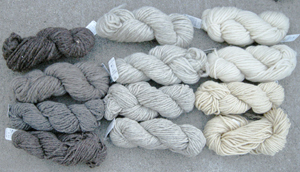
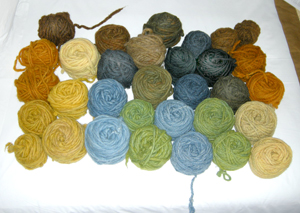 With wool I manage color range by using white, lite, medium and dark sheep gray from Bartlett Yarns. The only other fiber I work with is cotton and I’m trying out using white, brown and green cotton for the range but that is still in the we’ll-see phase.
With wool I manage color range by using white, lite, medium and dark sheep gray from Bartlett Yarns. The only other fiber I work with is cotton and I’m trying out using white, brown and green cotton for the range but that is still in the we’ll-see phase.
I’ve turned out to be a rather rotten blogger. I have this idea of only writing where there is something appropriate and relevant and then somehow not getting back to it for a few months.
The plants last seen around September 14 have mostly survived. Woad in porch planters were eaten by something. The Woad in the yard took off though one Weld didn’t survive. Additionally I have some more seeds in flats that will hopefully take off.
[Woad]
[Three Weld plants in front, the Woad nearest the tree and another Weld behind.]
[One of the Weld plants.]
Due to drought conditions – I’m in southern California – there are watering restrictions. On my street odd numbered addresses have Mon, Wed, Fri and Sunday, before 9am and later in the evening for watering. For awhile now I’ve been using dish (washing) water on the dye plants and they seem to be doing ok along some shade from the tree.
My other yellow dye staple is Oxalis, aka the Weed-that-does-not-die. That one is of course did well for it’s seasonal appearance and keep a lot of bees happy while providing me with a good supply of yellow/orange dye.